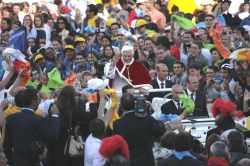In the Apostolic Constitution Pastor Bonus (art. 134) concerning the role of the Pontifical Council for the Laity, we read: “Within the parameters of its own competence, the Council performs all activities regarding lay associations of the Christian faithful; it erects associations of an international character and provides approval or recognitio for their statutes [...]. As for secular third orders, the Council deals only with those matters concerning their apostolic activities”.
The document that we now consider to be the magna charta of the Catholic laity is the post-synodal apostolic exhortation Christifideles Laici. It is here that Blessed John Paul II speaks of “a new era of group endeavours of the lay faithful” in which “alongside the traditional forming of associations, and at times coming from their very roots, movements and new sodalities have sprouted”. In recent years this new era has flourished with the continuous growth of new fruits that have been stimulated by certain events that we could call historic.
The first of these was John Paul II’s meeting with ecclesial movements, associations and new communities in Saint Peter’s Square on 30 May 1998, the Pentecost vigil. On that occasion, John Paul II opened up a new horizon to these ecclesial groups for the third millennium: “Today a new stage is unfolding before you: that of ecclesial maturity. This does not mean that all problems have been solved. Rather, it is a challenge. A road to take. The Church expects from you the ‘mature’ fruits of communion and commitment”.
We would also like to mention here the world congress of ecclesial movements on the theme: “Ecclesial movements: communion and mission at the threshold of the third millennium”, that was organised by the Pontifical Council for the Laity. The then-Cardinal Joseph Ratzinger gave his landmark lecture entitled “Ecclesial movements and their theological position” in which he gave the historical and theological background to the origins of associations of the faithful in the Church. He also opened up new perspectives for collaboration and closer unity between the pastors of the local Church and the movements.
We also remember the second international gathering of movements and new communities in Saint Peter’s Square on 3 June 2006, the Pentecost vigil. This was something that Pope Benedict XVI requested right from the beginning of his pontificate. His meeting with all of the ecclesial groups responded to the desire expressed when he initiated his petrine ministry.
This continuous growth in the number of ecclesial groups places corresponding demands on the Pontifical Council for the Laity. Our dicastery has the delicate responsibility of discernment regarding these new forms of community. It requires careful and precise study of current canonical norms as well as the exercise of its potestas iurisdictionis.
Our dicastery rejoices in the flourishing growth of ecclesial groups of the faithful and is conscious of the high regard for these groups that has been shown by the pontiffs. Through this section, we aim to maintain contact with these groups, to follow their development and itinerary, to evaluate their teaching methods and their apostolic outreach, to encourage them to get to know each other, to provide opportunities for meetings and cooperation, and to facilitate collaboration between ecclesial groups and the pastors of the local Church. The overall aim is to recognise the great treasure we have in their presence in the mission of the Church and to encourage ecclesial communion in diversity and complementarity of charisms.








